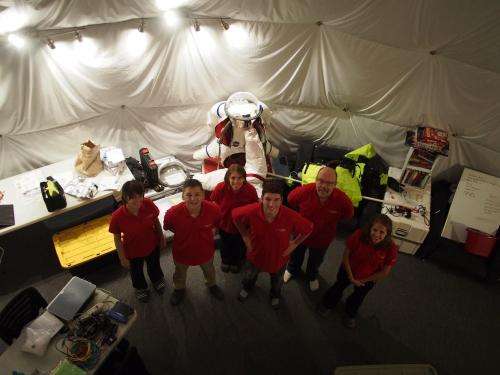After four months on simulated Mars, HI-SEAS team is as strong as ever

Real astronauts would be jealous: re-entry was just that easy. For the crew members of the Hawai'i Space Exploration Analog and Simulation (HI-SEAS) mission, returning to Earth after four months on simulated Mars was as simple as opening a faux airlock door.
Blinking and smiling in the harsh sunlight, the researchers stepped across the threshold and into the welcoming arms of their ground support crew and other observers gathered early on Friday morning. These were the first people outside of their own small group that the researchers have touched or seen since they entered their remote space habitat on the slopes of Mauna Loa on March 28.
"This crew has proven to be a strong team throughout the duration of the study," said Kim Binsted, associate professor at the University of Hawai'i at Mānoa and principal investigator for the HI-SEAS research effort. "By monitoring their inter-personal interactions, especially during times of stress, we're learning more about the social and emotional factors that determine astronaut crew cohesion. This is a big gap for NASA right now."
Under the HI-SEAS study, Binsted and her collaborators have used video cameras, electronic surveys, crew reports and other sources to keep a watchful eye on the crew inside the habitat.
"Being isolated from the world is tough to deal with, even when you've got company," Binsted said. "HI-SEAS will help us to understand how teams of astronauts will perform under the isolation conditions required for long-duration space travel—such as the kind of trips it would take for humans to get to Mars."
It takes an unmanned spacecraft between 150 to 300 days to travel between Earth and the red planet. Scientists estimate that a manned journey to Mars will take around three years, round trip.
In addition to the crew cohesion study, each of the researchers brought his or her own research project to complete while on simulated Mars. These projects focused on growing plants for human consumption in space, a trash-to-energy conversion study, and the utility of 3D printed surgical tools, among other topics.
The current mission is the first – and shortest – of three new space analog missions focused on human performance factors currently planned for the HI-SEAS habitat site on Mauna Loa, Hawaiʻi. Crew members have not yet been announced for the eight-month mission scheduled to kick off this October. A year-long mission will begin in 2015.
Provided by University of Hawaii at Manoa





















